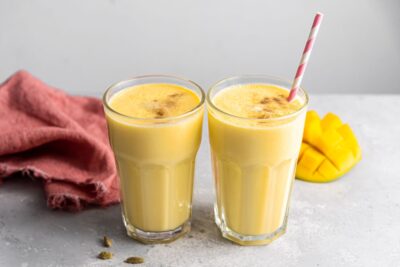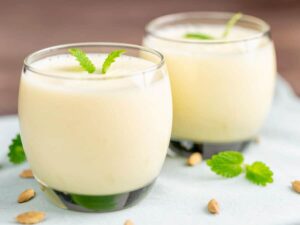In the vibrant tapestry of Indian cuisine, a lassi drink stands out as a refreshingly delightful and culturally significant beverage. Whether you’re wandering the bustling streets of Mumbai or savoring the flavors of Punjab, you’re bound to encounter this beloved concoction. But what is a lassi drink?
To answer this question, we’ll embark on a journey to explore the origins, variations, and the irresistible charm of this iconic Indian drink. So, grab a seat and prepare to quench your thirst for knowledge as we delve into the world of lassi.
What is a lassi drink?
A lassi drink is a traditional and popular beverage in Indian cuisine. It is known for its delightful blend of yogurt, water, and various flavorings, making it a refreshingly cool and creamy drink enjoyed throughout the Indian subcontinent. Lassi is often served in a variety of ways, catering to both sweet and savory preferences.
The two primary types of lassi are:
- Sweet Lassi: This version is made by blending yogurt with water, sugar, and sometimes fruit, such as mango, rosewater, or cardamom. It results in a sweet and creamy beverage, often consumed as a refreshing drink on a hot day or alongside spicy dishes to balance their flavors.
- Savory Lassi: Savory lassi is prepared by mixing yogurt with water, salt, and spices like cumin or black pepper. It is a bit tangy and can have a thin or thick consistency. Savory lassi is often enjoyed with meals, and it’s believed to aid digestion.
Lassi is not only a delicious and thirst-quenching drink but also carries cultural significance in India. It’s a versatile beverage that can be customized with various ingredients and flavors to suit different tastes.
Whether you prefer the sweet or savory variety, lassi is a cherished part of Indian culinary heritage and a favorite choice for cooling down in the heat or complementing spicy and flavorful Indian dishes.
Where does lassi originate from?
Lassi originates from the Indian subcontinent, and its history can be traced back many centuries. It is particularly associated with the northern regions of India, such as Punjab, Haryana, and Rajasthan.
The exact origin of lassi is not well-documented, but it is believed to have evolved as a traditional yogurt-based drink in this region due to the abundant availability of yogurt and the need for cooling, refreshing beverages in the hot climate.
Lassi has been a staple in the diets of people in these areas for a long time, serving both as a way to beat the scorching summer heat and as a complement to the rich and spicy dishes of Indian cuisine.
Over the years, it has gained popularity not only in India but also among people with an appreciation for diverse and delicious beverages worldwide. Today, lassi is enjoyed in various forms and flavors, both within India and in many other parts of the world, often adapting to local preferences and ingredients.
What are the primary ingredients in a traditional lassi?
The primary ingredients in a traditional lassi are simple and consist of the following:
- Yogurt (Curd): Yogurt is the base ingredient for lassi. It provides the creamy and tangy foundation of the drink. In traditional lassi, plain full-fat yogurt is typically used.
- Water: Water is added to the yogurt to achieve the desired consistency. The amount of water can be adjusted to make the lassi thinner or thicker, depending on personal preference.
- Sugar (for Sweet Lassi) or Salt and Spices (for Savory Lassi):
- Sweet Lassi: To make sweet lassi, sugar is added to provide sweetness. The amount of sugar can be adjusted according to taste. Additionally, flavorings like rosewater, cardamom, or fruit puree (e.g., mango) may be added for extra sweetness and flavor.
- Savory Lassi: In savory lassi, instead of sugar, salt and spices like cumin, black pepper, or ground coriander are added to enhance the savory and tangy taste. Sometimes, fresh herbs like cilantro or mint are included for added flavor.
These are the fundamental ingredients for a classic lassi. However, lassi can be customized with various other ingredients, such as fruit, nuts, saffron, and even a dollop of cream for richness.
The versatility of lassi allows for a wide range of flavor variations, making it a refreshing and adaptable beverage enjoyed in many different forms across the Indian subcontinent and beyond.
Are there different types of lassi?
Yes, there are several different types of lassi, each with its own unique flavors and ingredients to suit various preferences and occasions. The two primary categories of lassi are sweet and savory, but within these categories, there are numerous variations. Here are some of the most popular types:
- Sweet Lassi:
- Mango Lassi: This is perhaps one of the most famous sweet lassi varieties. It’s made by blending yogurt with ripe mango pulp, sugar, and a touch of cardamom. It offers a delightful tropical flavor.
- Rose Lassi: Rosewater is added to sweet lassi, giving it a fragrant, floral note along with the sweetness.
- Banana Lassi: Ripe bananas are blended with yogurt and sugar to create a creamy, banana-flavored lassi.
- Strawberry Lassi: Fresh or frozen strawberries are blended into the lassi, adding a fruity and slightly tangy twist.
- Pineapple Lassi: This version combines yogurt with pineapple chunks and a bit of sugar, creating a refreshing and tropical taste.
- Savory Lassi:
- Plain Salted Lassi: This is the most basic form of savory lassi, made with yogurt, water, salt, and sometimes a pinch of roasted cumin. It’s a popular choice for aiding digestion.
- Jeera (Cumin) Lassi: Cumin seeds are roasted and ground before being added to plain salted lassi, enhancing its earthy and aromatic flavors.
- Mint and Coriander Lassi: Fresh mint and coriander leaves are blended into the lassi, providing a herbal and refreshing taste.
- Spicy Lassi: This lassi incorporates green chilies, ginger, and sometimes even a touch of garlic for those who enjoy a spicier kick.
- Buttermilk (Chaas):
- Buttermilk is a close cousin to lassi and is often consumed as a digestive drink. It’s made by diluting yogurt with water and adding spices like cumin, salt, and sometimes curry leaves.
These are just a few examples of the diverse lassi offerings available in Indian cuisine. Lassi is a versatile beverage that can be customized with a wide range of ingredients, allowing for creativity and adaptability in satisfying a variety of tastes and occasions.
Is yogurt the main component of a lassi?
Yes, yogurt (also known as curd in some regions) is the main component of a lassi. Yogurt serves as the primary base and defines the creamy and tangy character of this traditional Indian beverage.
It is what gives lassi its distinctive texture and flavor. To make a lassi, yogurt is typically blended with water, and then various other ingredients like sugar, spices, fruits, or herbs are added to create the desired flavor profile, whether sweet or savory.
Yogurt is not only the main component but also a crucial element that provides the characteristic richness and creaminess to the lassi. It also contributes to the drink’s probiotic and nutritional qualities, making lassi not only delicious but also a potentially beneficial addition to one’s diet.
Is lassi typically served chilled?
Yes, lassi is typically served chilled. It is a refreshing beverage, and the cold temperature enhances its ability to quench thirst and provide relief from the heat, especially during hot and humid weather in many parts of India.
Also, chilling the lassi helps make it more enjoyable and soothing, as it cools the palate and complements the often spicy and flavorful nature of Indian cuisine.
To serve lassi cold, it is commonly refrigerated for some time before being poured into glasses or clay pots, and sometimes ice cubes are added for an extra chill.
In addition, sweet lassis are often garnished with a sprinkle of ground pistachios or almonds, while savory lassis may have a touch of freshly crushed cumin on top.
Chilled lassi is not only a delightful beverage on a scorching day but also a wonderful accompaniment to a variety of Indian dishes, whether you’re savoring a spicy curry or enjoying a traditional thali meal.
Health benefits associated with drinking lassi
Drinking lassi, whether sweet or salty (savory), can offer several health benefits when consumed as part of a balanced diet. Here are some of the potential health benefits associated with lassi:
- Probiotic Benefits: Lassi is made from yogurt, which is rich in probiotics. Probiotics are beneficial bacteria that can aid in digestion and promote a healthy gut. They can help improve the balance of gut flora and may alleviate issues like indigestion and constipation.
- Rich in Nutrients: Lassi is a good source of essential nutrients, including calcium, protein, vitamin B12, and probiotics. These nutrients are vital for bone health, immune function, and overall well-being.
- Hydration: Lassi contains water, making it a hydrating beverage, especially when served cold. Staying well-hydrated is essential for various bodily functions.
- Cooling Effect: Lassi is known for its cooling properties, making it a popular choice during hot weather. It can help lower body temperature and alleviate the discomfort of heat-related issues.
- Digestive Aid: Savory lassi, in particular, is believed to aid digestion due to the presence of spices like cumin and black pepper. These spices may stimulate digestion and reduce bloating or gas.
- Weight Management: Lassi can be a satisfying and low-calorie beverage, especially when prepared with low-fat yogurt. It can help control appetite and may support weight management when consumed as part of a balanced diet.
- Vitamins and Minerals: Lassi can be enriched with various vitamins and minerals, depending on the ingredients used. For example, mango lassi provides vitamin C and dietary fiber, while lassi with mint adds vitamins A and C.
- Immune Support: The probiotics in lassi can help strengthen the immune system by promoting a balanced gut microbiome. A healthy gut is essential for immune function.
- Stress Reduction: Some people find the act of sipping on a comforting lassi to be a stress-reliever, as it provides a moment of relaxation and enjoyment.
It’s important to note that the health benefits of lassi may vary depending on the specific ingredients used. For example, the health benefits of sweet lassi may differ from those of salty lassi. Additionally, lassi should be consumed in moderation, especially if sweetened with sugar, to avoid excessive calorie intake.
Overall, lassi can be a nutritious and enjoyable addition to your diet, offering both flavor and potential health advantages when prepared with wholesome ingredients.
What role does lassi play in Indian cuisine?
Lassi plays a significant and multifaceted role in Indian cuisine, serving as a beloved and versatile beverage that complements various aspects of Indian culinary traditions. Here are some of the key roles that lassi plays in Indian cuisine:
- Refreshing Beverage: Lassi is commonly consumed as a refreshing and cooling beverage, especially during the hot and sweltering Indian summers. Its chilled nature helps quench thirst and provides relief from the heat.
- Digestive Aid: Savory (salty) lassi, often seasoned with spices like cumin and black pepper, is known for its digestive properties. It is believed to aid in digestion, alleviate bloating, and promote a healthy gut.
- Balance for Spicy Dishes: Lassi serves as a perfect accompaniment to spicy Indian dishes. The cool and creamy texture of lassi helps balance the heat of spicy curries, biryanis, and other dishes. It provides a soothing contrast to the fiery flavors.
- Hydration: Lassi’s hydrating properties make it a suitable choice for staying refreshed, especially when consumed during or after a meal.
- Cultural Significance: Lassi is deeply embedded in Indian culture and traditions. It is often served during festivals, weddings, and other special occasions, symbolizing hospitality and warmth.
- Variety of Flavors: Lassi is incredibly versatile and can be prepared with a wide range of flavors. The ability to customize lassi with ingredients like fruit purees, spices, and herbs allows it to cater to diverse tastes and preferences.
- Nutritional Value: Lassi is a good source of nutrients, including calcium, protein, and probiotics. It contributes to the overall nutritional balance in the Indian diet.
- Street Food: Lassi is a popular street food in India, readily available from lassi shops and street vendors. It provides a quick and satisfying snack or refreshment for people on the go.
- Dessert Alternative: Sweet lassi, especially varieties like mango lassi, is often considered a dessert-like treat. It offers a delightful and healthy alternative to conventional desserts.
- Regional Variations: Lassi exhibits regional diversity in India, with variations in ingredients and flavors reflecting the culinary traditions of different regions. For example, the famous mango lassi is more prevalent in the northern regions, while buttermilk-based lassi (chaas) is commonly enjoyed in the south.
Conclusion
On this page you will get to learn more on what is a lassi drink. A lassi drink is a classic and versatile beverage originating from the Indian subcontinent. It is characterized by its primary ingredient, yogurt, which is blended with water and various flavorings to create a refreshing and creamy concoction.
Lassi comes in two main varieties: sweet and savory, each offering a unique taste experience. Whether enjoyed as a cooling refreshment, digestive aid, or flavorful complement to spicy cuisine, lassi plays a significant role in Indian culinary traditions and continues to captivate taste buds worldwide with its diverse and delightful flavors.




